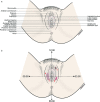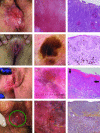Vulvar malignancies: an interdisciplinary perspective
- PMID: 31829526
- PMCID: PMC6972795
- DOI: 10.1111/ddg.13995
Vulvar malignancies: an interdisciplinary perspective
Abstract
Vulvar cancer represents the fourth most common gynecologic malignancy and is often encountered by the general Dermatologist or Gynecologist. Dermatooncologists and Gynecologic Oncologists share expertise in this field and the diagnosis and treatment should ideally be interdisciplinary. All subtypes are typically seen in the later decades of life, although all histologic subtypes have been described in women younger than 30 years. The diagnosis is often delayed. Exact mapping of biopsies is of high importance, as the location and distance from the midline guides the surgical approach depending on the underlying histology. Squamous cell carcinoma accounts for more than 76 % of vulvar cancer with vulvar intraepithelial neoplasia being an important precursor. Basal cell carcinoma is the second most common vulvar malignancy. Melanoma accounts for 5.7 % of vulvar cancer and has a worse prognosis compared to cutaneous melanoma. Most of the trials on checkpoint inhibitors and targeted therapy have not excluded patients with vulvar melanoma and the preliminary evidence is reviewed in the manuscript. Surgery remains the primary treatment modality of locally resectable vulvar cancer. In view of the rarity, the procedure should be performed in dedicated cancer centers to achieve optimal disease control and maintain continence and sexual function whenever possible.
© 2019 The Authors. Journal der Deutschen Dermatologischen Gesellschaft published by John Wiley & Sons Ltd on behalf of Deutsche Dermatologische Gesellschaft.
Conflict of interest statement
None.
Figures




References
-
- Stranding S. Gray's Anatomy: The Anatomical Basis of Clinical Practice. 41st ed Elsevier; 2015.
-
- Siegel RL, Miller KD, Jemal A. Cancer statistics, 2019. CA Cancer J Clin 2019; 69: 7–34. - PubMed
-
- ECIS – European Cancer Information System [Internet] . Available from: https://ecis.jrc.ec.europa.eu [cited 2019 Aug 14].
-
- Surveillance, Epidemiology, and End Results (SEER) Program (http://www.seer.cancer.gov) SEER*Stat Database: Incidence – SEER 18 Regs Research Data + Hurricane Katrina Impacted Louisiana Cases, Nov 2018 Sub (1975–2016 varying).
-
- Koh WJ, Greer BE, Abu‐Rustum NR et al. Vulvar Cancer, Version 1.2017, NCCN Clinical Practice Guidelines in Oncology. J Natl Compr Canc Netw 2017; 15: 92–120. - PubMed
Publication types
MeSH terms
LinkOut - more resources
Full Text Sources
Medical

